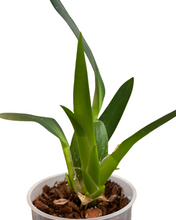These plants are no longer in bloom.
Brassia are part of the Orchidaceae family and their native range is S. Florida, Mexico to Tropical America. This particular plant is a cultivar of a Brassia and an Oncidium, the ‘gx’ means Grex, a term used to describe a mixture of varieties growing together and encouraged to cross-pollinate. The seeds from those crosses are grown out again and again. Instead of crossing two parents to create offspring, the breeder crosses dozens. The word Grex comes from the Latin meaning 'flock'.
Brassidium are sympodial orchids with new growth emerging from the pseudobulb, they are often called ‘Spider Orchids’ due to the shape of the flowers and based on their pollination characteristics. Flowers have a spreading shape with 5 elongated sepals which are a light yellow-green with splashes of deep plum, their scent is said to be pleasant and somewhat spicy.
Genus name was given by Robert Brown when he introduced the genus in 1813 in honour of William Brass, Esq., a botanical illustrator who collected plants for Sir Joseph Banks in Guinea and South Africa.
Pot: ø 12cm.
Height: Approximately 60cm from base of pot.
Light: Bright indirect light, meaning the plant sees the sun for 0-4 hours per day - this could be through trees or a translucent curtain, by reflected sun or through a skylight. 2-3 hours of direct sun is tolerable.
It is also worth considering how bright a particular spot is in winter vs summer; direct sunlight at noon in the summer could burn leaves.
Water: Water with lukewarm water when the about ¾ potting mix is dry; if the plant is particularly dehydrated its pseudobulb will wrinkle and leaves may develop an accordion appearance.
Potting mix: Ideally pot in a chunky mix made up of pine bark, sphagnum moss and some horticultural charcoal.
Fertilising: Feed monthly using a well balanced fertiliser. You can further dilute fertiliser than the recommended amount but never add more.
Temperature: 21-24˚C. Provide night temperatures of 12-18˚C for 2-4 weeks when the plant has stopped flowering to encourage new flower spikes.
Humidity: Although Brassidium prefers higher humidity they do well to adapt to average home humidity.
Blooming information: When your flowers are spent, cut the spike to the base, Brassidium don’t branch out or produce keikis like Phalaenopsis, they produce a new pseudobulb from the old pseudobulb. Don’t remove the old pseudobulbs as they are a water and nutrient store for the plant.
The plant is growing during spring and summer, when the temperature drops in autumn/winter it begins to initiate growth of a flower spike. This can vary as commercial greenhouses use temperature to ensure plants are in bloom when purchased so just bear with your plant if it has a dormant year.
Brassidium are non-toxic.







